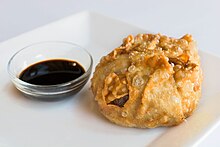Dim sim
 A steamed dim sim | |
| Type | Dumpling |
|---|---|
| Course | Appetiser or snack |
| Place of origin | Australia |
| Serving temperature | hot |
| Main ingredients | Meat, cabbage |
| Variations | Vegetarian (assorted fillings) |
A dim sim is a Chinese-inspired meat and vegetable dumpling-style snack food, popular in Australia[1] and to a lesser extent in New Zealand. It was originally offered to miners in the goldfields of Australia in the 1800s and used mutton as its primary meat. It was popularized by a Chinese immigrant in Melbourne who originally came from Guangdong, William Chen Wing Young, the father of Australian celebrity chef, author and TV personality Elizabeth Chong.[1] The name derives from the pronunciation diim syiim (點心) in Toisanese, the predominant dialect spoken at the time by central Melbourne's Chinese community.
The commercial snack food normally consists of minced meat, cabbage, and seasoning, encased in a wrapper similar to that of a traditional shumai dumpling. They are typically rectangular, or sometimes a larger circular shape. They can be served deep fried or steamed and are commonly dressed or dipped in soy sauce. An alternative way of cooking dim sims is to barbecue them, by cutting the dim sim in half along the long side and placing on a hot barbecue. Vegetarian-style dim sim normally contains cabbage, carrot, vermicelli, Chinese shiitake mushroom or other vegetable fillings, along with seasoning, although these are not generally available in commercial outlets.
Dim sims differ from typical Chinese dumplings in that they are often much larger, have a thicker, doughier skin and are shaped more robustly.[2] They are primarily sold in fish and chip shops,[1] service stations, corner shops, and some Chinese restaurants and takeaway outlets in Australia. Chinese yum cha wholesale outlets and Asian frozen food companies also commonly sell this snack frozen for home cooking. They can also be found at Chinese food outlets in New Zealand.
The term dim sim dates as far back as 1928,[3] although the modern recipe of the dish most likely was developed in Melbourne's Chinatown in 1945 by entrepreneur William Wing Young (father of TV chef Elizabeth Chong) for his food processing company Wing Lee.[4][2] The larger circular version of the dish is commonly known as a "South Melbourne dim sim" due to it originating at South Melbourne Market.

A fried dim sim (South Melbourne style) with soy sauce
Original recipe[]
William Wing Young's "original recipe" for the dim sim was presented by Elizabeth Chong on the second episode of the ABC1 TV show Myf Warhurst's Nice (20 June 2012). It consisted of pork, prawns, water chestnuts, spring onions and soy sauce wrapped in a soft skin-like wrapper.[5]
See also[]
References[]
- ^ a b c "Dim sims: The history of a Chinese-Australian icon". ABC News. February 8, 2016. Retrieved November 5, 2016.
- ^ a b "Dim Sims". Only Melbourne. Retrieved 2008-06-25.
- ^ James Lambert. "Australian National Dictionary Centre". Additions to the Australian lexicographical record III. Archived from the original on 2014-03-01. Retrieved 2014-03-12.
- ^ "Historyonics: the Dim Sim". Radio National. June 12, 2013. Retrieved November 5, 2016.
- ^ "Myf Warhurst's Nice". Episode 2 - Nice and Tasty. Retrieved 2013-11-12.
External links[]
- Australian snack foods
- Australian cuisine
- Dumplings
- Chinese-Australian culture
- Australian Chinese cuisine
